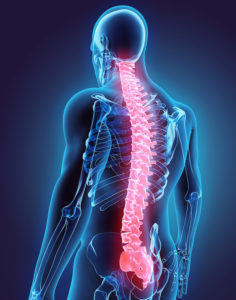 Spinal stimulation has been used to relieve pain for decades, but in recent years the technology has grown significantly advanced and is revolutionizing the field of pain management.
Spinal stimulation has been used to relieve pain for decades, but in recent years the technology has grown significantly advanced and is revolutionizing the field of pain management.
About Spinal Cord Stimulators
A spinal cord stimulator (SCS) is an implanted device that is used to deliver electrical charges for the purpose of disrupting pain signals to the brain. This device is used in select patients with chronic pain that has not subsided after conservative options have been exhausted.
While the device is not designed to, nor does it take away the source of pain, it does help interfere with pain signals in the afferent nervous system. There are many theories on pain and what exactly causes it, but the most widely accepted explanation “gate-control theory.”
The gate-control theory suggests that pain signals are sent to the spinal column, and if strong enough they override the gate and get sent to the brain for processing. There are a number of factors that dictate the pain threshold, each being unique to the individual.
Who is a candidate for spinal cord stimulation?
In order to be a candidate for a spinal cord stimulator, one must have chronic pain that has not subsided without return by previous treatments. These treatments may include prescription medication, physical therapy, injections, and alternative treatment methods such as yoga or meditation.
About the procedure
Prior to implanting the device, a trial run is often performed in which X-ray technology is used to guide leads (wires) to the targeted area of the spinal column portions. The leads are connected to an external device that is worn for a short period of time, usually around 5-7 days, to see if the pain relief benefits warrant implantation.
An estimated 80% of patients that undergo the trial report a 50% decrease in pain and/or 50% improvement in function–the threshold for which implantation is generally recommended.
The trial procedure is performed just like an epidural procedure and requires no incision. Patients may experience mild discomfort, but there is no pain or recovery period associated with the trial. Regardless of the results, the leads are removed after the trial period is over.
The spinal cord stimulator implantation procedure, considered minimally invasive, is an outpatient procedure. It requires two small surgical incisions each about 2-3 inches in length to secure the leads and to connect the generator device.
All of the surgical work is done in the layer of fat just beneath the surface of the skin, with each incision only about one-inch deep. This implantation procedure does not involve the muscles or bones.
Following the procedure, the patient is given a remote that controls the amount of stimulus delivered, depending on how much is necessary to override pain signals.
The recovery from the procedure is generally rather quick due to the minimal invasiveness of the operation. There may be some activity restrictions for up to 6 weeks following implantation, but a spinal cord stimulator is much less invasive than decompressive spine surgery.
What are the benefits?
In addition to decreased pain and improved function, spinal cord stimulators offer durability and longevity. Though intended to be a permanent solution, should the SCS no longer provide relief, the device can be fully removed at any time.
Aside from having to periodically be recharged or have the battery replaced, there is little ongoing maintenance involved with a spinal cord stimulator. If needed, there are various reprogramming options that can be done in the office to change the stimulation pattern.
The majority of patients continue to experience the same benefits they experienced during the trial period for many years after implantation.
Are there any risks?
Spinal cord stimulation is extremely safe and easy for patients to tolerate in the hands of a pain fellowship trained physician. However, as with any procedure, there are some associated risks.
To reduce risks, patients are required to temporarily discontinue blood thinning medication prior to the procedure.
There is a risk of infection around 2.5%, and should infection occur, the system may have to be removed.
It’s important to note that if you are recommended for a spinal cord stimulator it is because the benefits to your quality of life were determined to outweigh the potential risks. An estimated 20% of patients may have some pain return, called tolerance, despite office reprogramming, but these patients almost always have better pain control than they did before the stimulator.
For More Information
Dr. Nael Shanti of Cary Orthopaedics Spine Center provides state-of-the-art spine care to patients in the Triangle area using the most advanced minimally invasive surgery techniques and outpatient procedures, including spinal cord stimulation. For more information about what treatment options may be available to you, call (919) 297-0000 to schedule an appointment.
